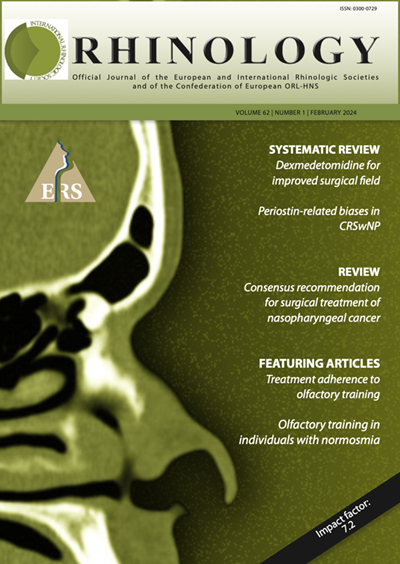Do not ignore mouth breathing syndrome: respiratory functions are affected in early childhood.
IF 4.8
2区 医学
Q1 OTORHINOLARYNGOLOGY
引用次数: 0
Abstract
INTRODUCTION Impulse oscillometry (IOS) is a useful test for measuring pulmonary resistance and reactance from the early ages. We aimed to investigate the etiological factors of mouth breathing syndrome (MB), its effects on respiratory functions, and to compare the results with those of children with nasal breathing (NB). METHODS This prospective cross-sectional study investigated children aged 3-7 years with MB (n=202) and NB (n=127) admitted to the pediatric allergy clinic between January 2023-2024. The MB group was evaluated for etiological factors by means of otorhinolaryngological examination. Respiratory function tests were evaluated using IOS and were repeated two months after appropriate treatment. RESULTS Adenoid hypertrophy (AH-44.0%), allergic rhinitis (AR-11.3%) and AH co-existent with AR (34.6%) were the principal causes of MB. Entire airway resistance was higher, upper and lower airway reactance were lower in the MB group compared to the NB group. No difference was detected in terms of IOS parameters between the first and second visits of MB group. Upper and entire airway resistance parameters were higher in children with AH and AH co-existent with AR groups compared to the non-obstructive group. Entire airway resistance was higher, upper and lower airway reactance were lower, in children with adenoid size>50% compared to those with adenoid size mouth breathing, allergic rhinitis, adenoids, respiratory function test, pediatrics.不要忽视口呼吸综合征:呼吸功能在幼儿期就会受到影响。
引言脉冲电流示波法(IOS)是一种从幼年开始测量肺阻力和肺反应的有效测试方法。我们的目的是调查口呼吸综合征(MB)的病因及其对呼吸功能的影响,并将结果与鼻呼吸综合征(NB)患儿的结果进行比较。MB 组通过耳鼻喉科检查评估病因。结果类鼻疽肥大(AH-44.0%)、过敏性鼻炎(AR-11.3%)和类鼻疽与过敏性鼻炎并存(34.6%)是导致 MB 的主要原因。与 NB 组相比,MB 组的整个气道阻力较大,上下气道反应较低。MB 组第一次和第二次就诊时的 IOS 参数未发现差异。与非阻塞组相比,AH 组和 AH 并存 AR 组儿童的上气道阻力和整个气道阻力参数更高。腺样体大小为>50%的儿童与腺样体大小为口呼吸、过敏性鼻炎、腺样体、呼吸功能测试、儿科的儿童相比,整个气道阻力更高,上下气道反应性更低。
本文章由计算机程序翻译,如有差异,请以英文原文为准。
求助全文
约1分钟内获得全文
求助全文
来源期刊

Rhinology
医学-耳鼻喉科学
CiteScore
15.80
自引率
9.70%
发文量
135
审稿时长
6-12 weeks
期刊介绍:
Rhinology serves as the official Journal of the International Rhinologic Society and is recognized as one of the journals of the European Rhinologic Society. It offers a prominent platform for disseminating rhinologic research, reviews, position papers, task force reports, and guidelines to an international scientific audience. The journal also boasts the prestigious European Position Paper in Rhinosinusitis (EPOS), a highly influential publication first released in 2005 and subsequently updated in 2007, 2012, and most recently in 2020.
Employing a double-blind peer review system, Rhinology welcomes original articles, review articles, and letters to the editor.
 求助内容:
求助内容: 应助结果提醒方式:
应助结果提醒方式:


